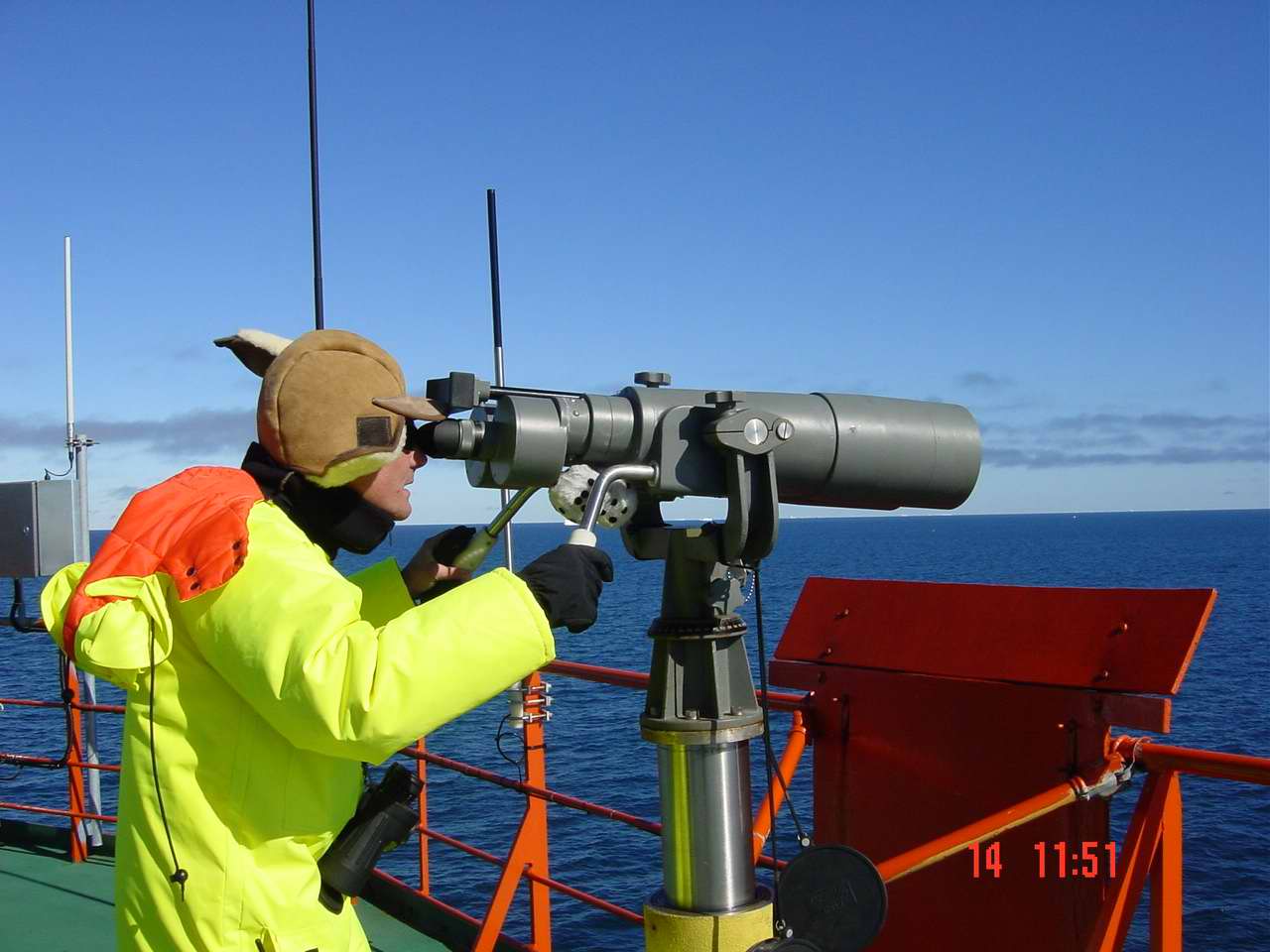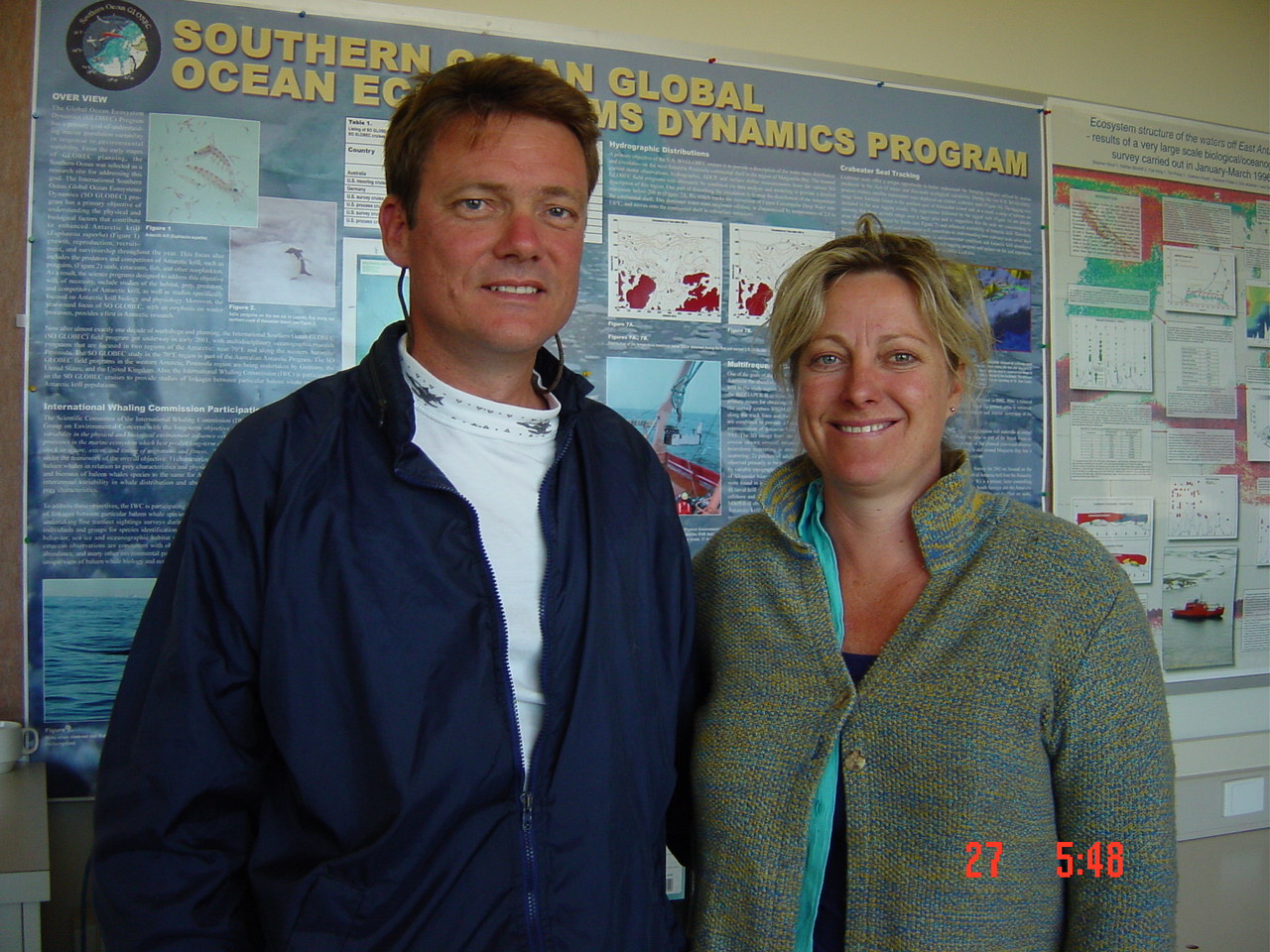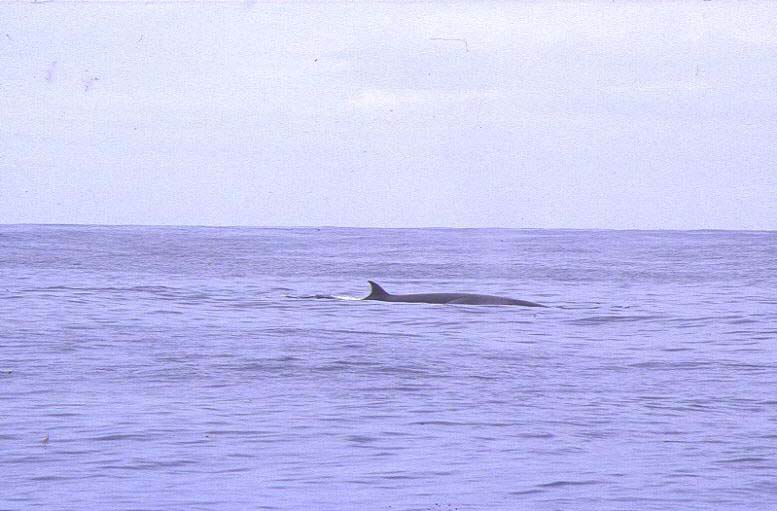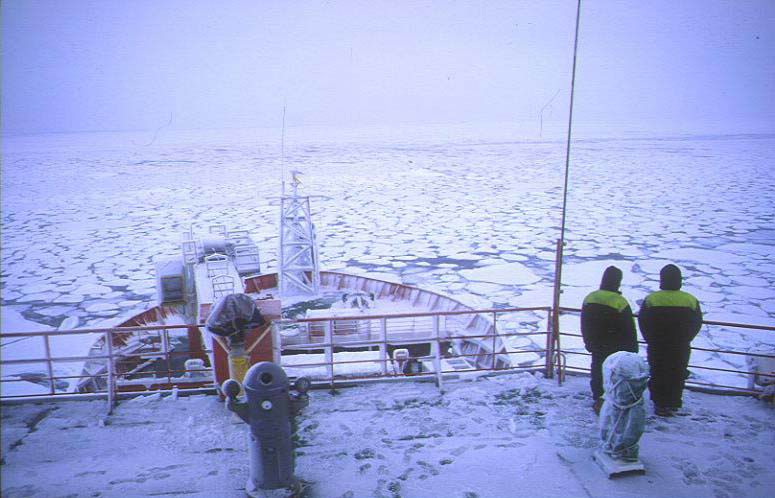Cetacean monitoring program.
The Southern Ocean Cetacean Ecosystem Program
(SOCEP) is designed for long-term monitoring of cetaceans on marine science
voyages in Antarctica. The data from these voyages are used as part of a
unified, multidisciplinary program to better understand the linkages between
oceanographic processes and the ecology of the Southern Ocean.
The cetacean research program was developed
through collaboration with CCAMLR, the International Whaling Commission, and
Southern Ocean GLOBEC with the long-term aim to: "define how spatial and
temporal variability in the physical and biological environment influence
cetacean species in order to determine those processes in the marine ecosystem
which best predict long-term changes in cetacean distribution, abundance, stock
structure, extent and timing of migrations and fitness."
An example of this type of collaborative,
ecosystem level work is the BROKE voyage of 95/96. Nicol et
al. (2000)
describe how ocean circulation off east Antarctica affects ecosystem structure
and sea-ice extent. Specifically, the results of the cetacean component of the
BROKE voyage are summarized by Thiele et al. (2000). The authors indicate that
baleen whale distribution could be explained by the long-term seasonal pattern
of interactions between sea-ice processes, oceanographic features and processes
that determine the conditions for high primary productivity and the
distribution of prey at a large scale, i.e. large-scale ecosystem processes can
explain the distribution and relative abundance of baleen whales. Subsequently, the KACTAS voyage (V6-2000/1)
attempted to record cetacean distribution and abundance in relation to krill
swarms in a first attempt to understand fine-scale predator/prey dynamics in
the sea off Mawson. Unfortunately, this research was interrupted;
however, preliminary data analysis indicated that whale abundance increased
along the shelf edge and the gyre found in the eastern portion of the
experimental ‘box’. This coincides with areas of increased krill
abundance. These preliminary results of
the 2000/1 study have led to the adoption of a stronger experimental approach
for V4 2002/3.

The current voyage will offer an opportunity to
collect more data on cetacean distribution, abundance, and behaviour relative
to their prey (krill) during dedicated fine-scale surveying. Additionally, the
whale observation team will be collecting fine-scale sea-ice data in a pilot
study to develop standardised collection of environmental data for future studies
investigating the role of the environment (habitat) in determining whale
abundance and distribution. This voyage
will also offer an opportunity to collect biopsy samples from whales. These samples will be used in genetic
analyses to help elucidate the stock structure of the species that inhabit the
waters around Antarctica.
Additionally, expendable sonobuoys
will be deployed simultaneously with the visual survey. An acoustic recording package will be
deployed in the research ‘box’ to record baleen whale calls year round (see
whale acoustics page).
Routine observations of cetaceans are made
throughout the voyage. Normally three observers are on the bridge at any time,
one each on the port and starboard sides of the bridge conducting a 45° arc search
from ship to the horizon, plus another person entering all sighting and
environmental data. Subject to the krill program and available space on the
workboat, cetacean personnel will use the workboat to gain biopsy samples. The
cetacean team comprises 4 people:

Vic Peddemors
Vic Peddemors, is an Associate
Professor in Zoology at the University of Durban-Westville, South Africa. He
has been researching cetaceans for 21 years, including captive-based studies
and investigations into the ecology and management of free-ranging cetaceans in
southern Africa. He is the African
co-ordinator for the IUCN Cetacean Specialist Group and has participated in
several International Whaling Commission Scientific Committee Meetings. This is his third research trip on the Aurora Australis
as part of the SOCEP Research Team. Vic
will act as whale research team leader during V4 2003.

Paul Hodda
Paul Hodda's interest
in cetaceans began in the late 1970's, when Australia still operated a whaling
station in Western Australia. He became active in the cetacean
conservation issues, and for the past decade has been president of the
Australian Whale Conservation Society. He represents cetacean
conservation interests on a number of government committees and working groups.
In 1979 he was part of a small team of volunteers who began monitoring the
recovery of the east coast humpback population, and coordinated an annual
survey from Cape Byron in New South Wales for 19 years. This is his sixth
voyage to the Southern Ocean as a whale researcher.

Catherine Bell
Catherine Bell recently completed her B,Sc. (Hons)
at Adelaide University working on common dolphin taxonomy in southern
Australian waters. Additional marine mammal experience includes:
~Assisting with a New Zealand fur seal
mark-recapture population estimation study on Kangaroo Island and Australian
Sea Lion counts off Streaky Bay, South Australia;
~A review of marine mammal-long liner
interactions in Australian waters;
~participation in a study
investigating humpback whale behaviour, acoustics and abundance off Peregian Beach, Qld.
~Participation in blue whale aerial surveys over
the Bonney Coast, off west Victoria. This is
Catherine’s first trip to Antarctica.

Shannon McKay
Shannon McKay completed an undergraduate degree
in Marine and Freshwater Science from Deakin
University, Warrnambool, Victoria in 2001. During her
studies she was involved in a number of cetacean projects including:
~Regular aerial surveys of the Victorian
coastline each summer tracking blue whales;
~A short theodolite
tracking study of the same blue whales off Portland, Victoria,
~Two months of humpback whale research with the
Centre for Whale Research in Exmouth, Western Australia;
~Brief exposure to research investigating
southern right whale genetics.
Subsequently Shannon has spent 10 weeks in Hervey Bay, Queensland, with the Oceania Project. Here she participated as a researcher
involved in humpback whale genetics and photo-identification and as a trainee coxwain. Later this year she plans to
start a B.Sc. (Hons) project in whale acoustics at Deakin University, Warrnambool.

The Principal Investigator is Dr. Deborah Thiele, based at Deakin University, Warnambool,
Australia (shown here with Vic Peddemors).

Image 1: Three orcas, or killer whales,
surfacing in pack ice.

Image 2: A surfacing Sei whale, with a
distinctive dorsal fin and colouration.

Image 3: WHALOS searching for whales from the flying bridge of the Aurora Australis.
More Information
Project 2253 - Distribution and abundance of
cetaceans (whales, dolphins etc.)
The Southern Ocean Cetacean Ecosystem Program
(SOCEP) is the only Australian cetacean research project operating in the
Antarctic. It forms one component of a long-term program within the Antarctic
Marine Living Resources Program (AMLR - Australian Antarctic Division) investigating
and monitoring the physical and biological processes operating in the Southern
Ocean off the Australian Antarctic Territory (AAT). SOCEP operates within an
'ecosystem' framework of multidisciplinary programs by conducting visual
cetacean surveys on Australian National Antarctic Research Expedition (ANARE)
marine science voyages to obtain a cetacean distribution time series. The
program also uses a range of other non-lethal research tools in collaboration
with local and international cetacean researchers (ie.
genetics, lipid studies, passive acoustics) to
contribute to specific management objectives of the International Whaling
Commission (IWC) and the IWC Southern Ocean Sanctuary.
This work will contribute towards our understanding of the likely effects of
environmental change on cetacean populations. Data, methods, reports and
publications from the program are shared with other researchers and contributed
to the IWC, CCAMLR and Southern Ocean GLOBEC.
The overall objective of the baleen whale
ecology component of the Mawson monitoring program
is: “to use a range of standard and new techniques to determine seasonal and
long term changes in distribution and abundance of these species within the
framework of a program that will provide concurrent data on prey and other
biological and physical processes over the same temporal scales”.
The research aims to address the following long term objectives identified for
baleen whale research in the Southern Ocean by the IWC, SOCEP and the AAD
strategic plan:
(1) Characterise foraging behaviour
and movements of individual baleen whales in relation to prey characteristics
and the physical and biological environment;
(2) Relate distribution, abundance and biomass
of baleen whale species to the same for krill in the same area over a number of
seasons;
(3) Monitor inter-annual variability in whale
distribution and abundance in relation to the physical environment and prey
characteristics.
To achieve these aims, we will conduct
ship-based visual studies to determine distribution and relative abundance of
baleen whales. We will deploy acoustic recording packages (which remain down
for one year and can then be retrieved and reset). These packages record
cetacean calls continuously throughout the year and will allow us to determine
relative abundance of some species of baleen whales throughout the year of
deployment. The data is also useful in determining peaks in seasonal abundance
for somespecies. Expendable sonobuoys
will be deployed throughout the voyage to monitor whale calls and locations.
Some ship time will be directed to conducting sonobuoy
experiments, particularly if blue whales are sighted or if any interesting
events or occurrences (such as concentrations of feeding or interacting
species) are encountered.
On encountering concentrations of feeding baleen whales, the small boat will be
used to conduct fine-scale ecological surveys, with concurrent krill studies
(to assist in integrating data at this scale), tissue biopsy (population
genetics) photo identification of individual animals (to match sex, population
and call information) and passive acoustic deployments (sonobuoys).
We will also be conducting small boat surveys with the krill team to look at
the distribution of whales along current boundaries and gyres, and within sea
ice to assist with the important issue of determining and directly measuring
the links between physical processes and the patterns of distribution of whales
and their prey. This information is critical to formulating models to predict
the impacts of environmental change on these species.
We will also collect faecal samples for an AAD
project investigating the feeding biology of whales. Our experience in working
in collaboration in the Western Antarctic Peninsula has convinced us of the necessity
of running passive acoustic studies in collaboration with visual and biopsy
studies. Using the full range of techniques available (visual, acoustic,
biopsy, photo identification) provides complementary data can be integrated to
provide a comprehensive picture of baleen whale ecology.